* U.S. corn sowing 2 pct larger than expected
* Soybean plantings a record, up 1 pct from 2012
* Corn, soy, wheat stocks smaller than expected
* Smallest June 1 soybean stockpile since 2004
WASHINGTON, June 28 (Reuters) – Chicago Board of Trade corn futures fell sharply following the release of USDA’s June acreage data that showed U.S. corn plantings this spring well above an average of analysts’ estimates, traders said.
U.S. farmers planted more corn than expected and a record amount of land to soybeans despite a wet, cold spring that slowed fieldwork, the government said on Friday.
Read Also

U.S. livestock: Hog futures hit contract highs on shock herd decline
Chicago | Reuters – Lean hog futures stormed to contract highs at the Chicago Mercantile Exchange on Friday as smaller-than-expected…
The large plantings put within reach record-setting corn and soybean crops than would end three years of tight supplies and high prices.
In a companion report, the U.S. Department of Agriculture said the corn, soybean and wheat stockpiles as of June 1 were smaller than the average trade expectations. But they were not the extreme surprises that USDA sometimes shows in the quarterly data.
Wheat was four percent below expectations at 718 million bushels, corn three percent lower than expected at 2.764 billion, and soybeans nearly two percent below the average guess, at 435 million bu.
Based on a survey of 70,000 farmers, the USDA pegged corn plantings at 97.379 million acres, the largest since 1936 and two million acres or two percent more than expected by analysts.
Soybean plantings were a record 77.728 million acres, up one percent from last year but 200,000 acres lower than the average forecast.
Farmers could harvest a record 13.9 billion bu. of corn, 3.4 billion bu. of soybeans and two billion bu. of wheat, USDA’s planting figures suggested, with normal weather and yields.
Rainy, snowy and cold weather put spring planting weeks behind its normal pace in much of the farm belt during April and early May.
Based on those conditions analysts expected farmers to shift some land to soybeans and cotton, which can be planted later, and away from corn and wheat. They also looked for overall plantings to fall short.
But improved weather in late May and June allowed farmers to catch up to a large degree.
Spring and durum wheat plantings were smaller than expected. Wheat plantings in North Dakota, the No. 2 producer, are down 10 percent from what growers planned in March.
Cotton plantings were up, to 10.3 million acres, from the March estimate of 10 million acres. Plantings are down 17 percent from last year.
Corn stocks are projected to dwindle to their smallest amount in 17 years by the time this year’s potentially huge crop is ready for harvest.
In rain-logged Iowa, No. 1 in corn and soybeans, corn acreage was down by 200,000 acres from the March estimate and soybeans were up by 100,000 acres. Nebraska and Minnesota corn plantings were down by 200,000 acres from the March estimate.
At the start of this week, the corn crop nationwide was lagging slightly on its usual rate of development but especially so in rainy Iowa. Soybeans were well behind normal in Iowa, Minnesota, Wisconsin and Missouri. In North Dakota, corn, soybeans and wheat were all significantly behind normal.
Late-developing crops are more at risk from summer heat waves or early freezes.















